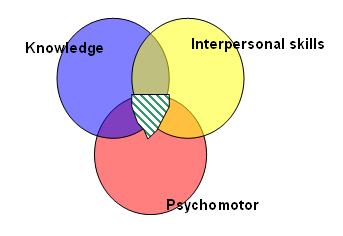Principles of Assessment
 You will have seen earlier how competence on qualification involves knowledge, skills, performance, attributes and qualities, and the way they are used in practice. Students need to develop the ability to go beyond adherence to rules and routines, becoming able to use their own judgement to act appropriately and effectively in changing circumstances. Assessment is a generic term for a set of processes that measure the outcome of students' learning, in terms of knowledge acquired, understanding developed and skills gained (QAA 2003). Assessing offers a way by which students can be graded, passed or failed. It thus provides the basis for decisions on whether a student is ready to proceed, qualify for an award or demonstrate competence to practise.
You will have seen earlier how competence on qualification involves knowledge, skills, performance, attributes and qualities, and the way they are used in practice. Students need to develop the ability to go beyond adherence to rules and routines, becoming able to use their own judgement to act appropriately and effectively in changing circumstances. Assessment is a generic term for a set of processes that measure the outcome of students' learning, in terms of knowledge acquired, understanding developed and skills gained (QAA 2003). Assessing offers a way by which students can be graded, passed or failed. It thus provides the basis for decisions on whether a student is ready to proceed, qualify for an award or demonstrate competence to practise.
Why assess?
![]() Consider the reasons why assessment of clinical ability is necessary; think of it in terms of the benefits to the student, the host institution and the profession.
Consider the reasons why assessment of clinical ability is necessary; think of it in terms of the benefits to the student, the host institution and the profession.
Spend a few minutes thinking about this and jot down your ideas.
Students are encouraged and motivated by an assessment that is appropriate and well conducted, providing timely feedback is given. The assessment provides a record of achievement with feedback giving guidance on how performance might be improved. While the actual process of preparing for assessment helps consolidate learning. The benefits to the host institution are: it enables individual performance to be monitored; it enables staff to evaluate the effectiveness of their teaching and in turn the success of the programme of study. The results from both clinical and academic assessments are combined giving a picture of the students overall ability. These results are used to allow progress through the programme of study leading to a demonstration of competence to practise. The host institution is also the academic awarding body. For the allied health professions an honours degree from a programme validated by the professional body allows eligibility for registration with the health professions council.
Competence to practise may be regarded as a phase in professional development, using a scale that starts with incompetence up to proficiency and ends with mastery. It is important to remember as a practice educator involved in assessment you should recognise that the competence you seek to help a student to achieve is only a stepping stone en route to mastery. While maintaining high professional standards, it is unrealistic to expect mastery in the timescales available to the undergraduate. Remember to be realistic in your expectations.
What is assessed?
The decision as to whether a student is competent to practice or not is made by assessing the development of knowledge, psychomotor and interpersonal skills regularly. Within each of these three areas there will be a wide range of ability, and the specific knowledge, skills and interpersonal behaviours required may vary from one clinical placement to another (Moore et al 1997). This can be represented diagrammatically (fig. 1), with the central area of overlap varying to demonstrate the degree of integration.
Fig. 1 The integration of knowledge, and interpersonal skills - hashed area of integration,
(Caney, 1983)

Types of assessment
Assessment can be either:
- Summative: takes place at the end of a unit of learning; it is concerned with a final judgment of performance.
- Formative: concerned with the improvement of performance. It takes place during the course of study allowing the student to benefit from feedback on their performance.
In broad terms marking and grading involve summative assessment while reviewing and giving feedback involve formative assessment (Gibbs et al, 1988). Assessment of students' competence is therefore complex and demanding, and the development and use of a framework for such assessment is vital.
There are advantages and disadvantages with any form of assessment, as well as individual personal preferences. In attempting to be fair to all students and produce realistic results with useful feedback, programmes use a variety of assessment tools as well as involving a number of staff.
 University programmes will all have their own assessment schemes for professional practice. Although many will be similar, it is vital that you, as a practice educator, familiarise yourself with the particular scheme used by your students. The assessment scheme will provide guidance on:
University programmes will all have their own assessment schemes for professional practice. Although many will be similar, it is vital that you, as a practice educator, familiarise yourself with the particular scheme used by your students. The assessment scheme will provide guidance on:
- Appropriate learning experiences for your student
- The evidence required to indicate progress
- Formative assessment - for on going supervision sessions and at the halfway stage of the placement
- Summative assessment - a final judgement of the performance of the student.
Some schemes provide a pass/fail grade for students, while others indicate their level of achievement; some combine both. Whatever the requirements, assessment is an integral part of the student's learning. As with other aspects of professional practice education, it is a collaborative process involving you, the student and the university. It will require that you:
- Interpret criteria/descriptors/overall aims in terms of your own service setting
- Consult with other colleagues involved in the professional practice education of the student
- Use your professional judgement to provide feedback which allows the student to reflect on his/her progress and which guides future development
- Provide written evidence for the university, to support your assessment, which is succinct, accurate, fair and which reflects the student's ability.
As well as providing guidance on how to carry out student assessment, universities will usually offer more direct help if required, and will expect you to inform them of a potential problem with a 'failing' student. Some assessment schemes expect the student to carry out an independent self-assessment, with the final grade(s) negotiated between practice educator and student; others ask for the assessment form to be completed jointly by the student and the practice educator.
Some final points:
- The student, and practice educator complete some assessment forms collaboratively. This will ensure that the expectations for each skill area, and the grade awarded, are understood and agreed by both of you.
- Students not achieving a sufficiently high grade to pass the placement will normally be allowed to re-sit the placement
- Some universities use the grade achieved by the student to contribute to the final mark and hence the award of the Honours Degree.
- Whatever scheme of assessment is encountered, using it to guide student learning and, in particular, as a 'halfway' check on student progress, will help you decide if your student is potentially failing. Coping with such a situation is the subject of the next section.
References
Brown, G. et al. (1997) Assessing Student Learning in Higher Education, London: Routledge.
Brown, S., and Knight, P. (1994) Assessing Learners in Higher Education, London: Kogan Page.
Caney D (1983) Competence - Can it be Assessed? Physiotherapy, Sept, Vol 69, no8, pp 127-129
Gibbs G, Habeshaw S, Habbeshaw T (1988) 53 Interesting Ways to Assess Your Students, Technical and educational services Ltd, Bristol
Moore A, Hilton R, Morris J, Caladine L, Bristow H (1997): The Clinical Educator - Role Development, Churchill Livingstone, New York.
QAA (2003): Code of Practice on Assessment, http://www.liv.ac.uk/tqsd/QAA/QAA.htm